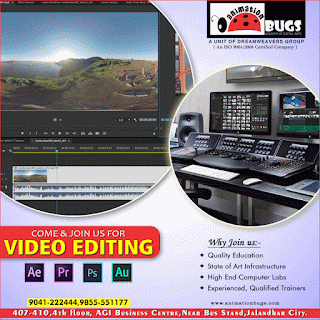Best Institute For Visual Effects in Jalandhar
VISUAL EFFECTS
Visual Effects (VFX) are the processes by which imagery is created or manipulated outside the context of a live action shot. Animation Bugs provides you the best training of visual effects.
Visual Effects involve the integration of live-action footage and generated imagery to create environments which look realistic, but would be dangerous, expensive, impractical, or impossible to capture on film. Visual effects using computer-generated imagery have recently become accessible to the independent filmmaker with the introduction of affordable and easy-to-use animation and compositing software.
Visual Effects May Be Divided Into:-
Ø Matte paintings: A Matte Painting is a painted representation of a landscape, set, or distant location that allows filmmakers to create the illusion of an environment that is not present at the filming location. Historically, matte painters and film technicians have used various techniques to combine a matte-painted image with live-action footage. At its best, depending on the skill levels of the artists and technicians, the effect is "seamless" and creates environments that would otherwise be impossible or expensive to film. In the scenes the painting part is static and movements are integrated on it.
Ø Digital effects: Digital FX is the process by which imagery is created or manipulated with or from photographic assets. Digital effects often involve the integration of still photography and Computer Generated Imagery (CGI) to create environments which look realistic but would be costly, or impossible to capture in camera.
COMPOSITING
Compositing is the combining of visual elements from separate sources into single images, often to create the illusion that all those elements are parts of the same scene. Live action shooting for compositing is variously called "Chroma Key" , blue screen", "green screen". Today, most, though not all, compositing is achieved through digital image manipulation. Animation Bugs is the best institute in Jalandhar for learning compositing.
Major factors of using green colour and blue colour
The most important factor for a key is the colour separation of the foreground (the subject) and background (the screen) – a blue screen will be used if the subject is predominately green (for example: plants), despite the camera being more sensitive to green light.
Lighting: In order to create an illusion that characters and objects filmed are present in the intended background scene, the lighting in the two scenes must be a reasonable match. For outdoor scenes, overcast days create a diffuse, evenly coloured light which can be easier to match in the studio, whereas direct sunlight needs to be matched in both direction and overall colour based on time of day.
A studio shot taken in front of a green screen will naturally have ambient light the same colour as the screen, due to its light scattering. This effect is known as spill. This can look unnatural or cause portions of the characters to disappear, so must be compensated for, or avoided by using a larger screen placed far from the actors.
Camera: The depth of field used to record the scene in front of the coloured screen should match that of the background. This can mean recording the actors with a larger depth of field than normal.



Comments
Post a Comment